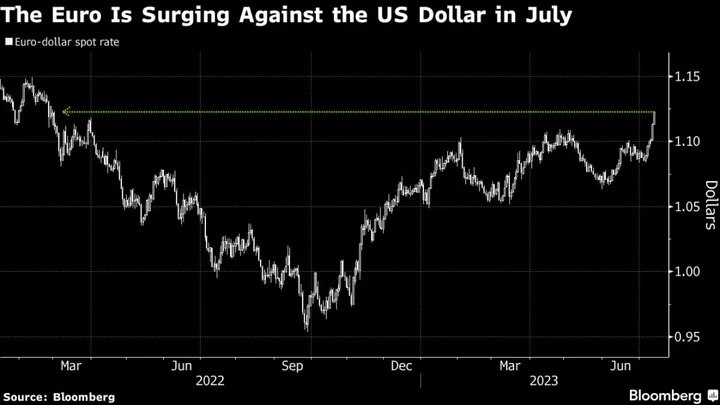For Stephen Jen, the famous dollar prognosticator, the Federal Reserve looks all set to win its war on inflation without tipping the US economy into a nasty recession.
That’s bad news for the world’s reserve currency and threatens to send shockwaves across foreign-exchange markets.
As expectations mount for a so-called soft landing in the US, the chief executive of London-based asset manager Eurizon SLJ Capital is once again touting the merits of his dollar-smile worldview. As the influential theory goes, the greenback typically gains when the US economy is either in a deep slump or a strong expansion — and lags in times of moderate growth, like now.
The evidence for the latter scenario, Jen says, is already forming as the dollar sinks to its lowest in more than a year, with traders betting consumer prices have peaked in the aftermath of the Fed’s aggressive policy tightening.
That downtrend is set to continue with public debt burdens and economic imbalances weighing on growth, according to Jen, a former economist at the International Monetary Fund.
“The dollar has been, and still is, very overvalued. It won’t take much for the dollar to converge back to their fair value,” he said in an interview. “I think the Fed will do one more rate hike and a soft landing can be achieved.”
This week has already made clear how quickly a slump in the greenback can rip across global financial markets, as a promising report on the US inflation trajectory spurred currency rallies from Sweden and Japan to South Africa and Peru. To Jen, the euro is primed to offer a fresh example of that momentum with a sprint to $1.20 within the next six months, a nearly 7% increase from current levels.
“Once the FOMC collective view on inflation is modified — which I think it will be soon — the dollar will weaken at at a much faster pace,” he said. “The dollar will no longer have a cyclical support.”
While a July rate increase is still all but assured, the rapid descent in price growth — now just a third of its 2022 peak rate — has offered fresh hope that the Fed can soon end its tightening cycle. Traders now see less than a 50% chance that the Fed opts for additional interest-rate increases after July.
All that, according to Jen, means investors will then have to wrestle with macro headwinds other than inflation or a potential recession: deficits. As the US has ramped up spending, public debt has increased to 118% of gross-domestic product from just 54% in 2000, according to St. Louis Fed data.
The nation’s current-account deficit, a shortfall between savings and investments, keeps worsening. And this means the US has built up a large net liability to the rest of the world, making — at least in theory — its currency vulnerable to a selloff in the event foreign investors dump dollar assets.
The theory finds some support from Paresh Upadhyaya, director of currency strategy at Amundi Asset Management.
“If you’re not seeing that flight to quality coming into Treasuries, how do you finance those deficits?” he said. “The dollar will have to depreciate to levels that are attractive enough to attract investors.”
The US economy slowing without plunging into a deep recession “is the worst case scenario as far as the dollar is concerned, because the risk trade is OK,” Alan Ruskin, chief international strategist at Deutsche Bank, said on Bloomberg Television. “Bonds like it. Equities like it. The dollar really does not like that scenario.”
Bloomberg’s dollar gauge has fallen nearly 4% this year.
Strategists have already begun to coalesce around Europe’s common currency as a big beneficiary. Deutsche Bank is targeting the common currency at $1.15 by year’s end, while Nomura Holdings Inc.’s forecasters see it hitting $1.14 by the end of September. Hedge funds are starting to embrace the trade with net longs among leveraged funds back at June highs, according to Commodity Futures Trading Commission data.
“This ‘neither hot nor cold’ economic scenario will allow investors to focus on the incredible structural weaknesses of the US and that should be negative for the dollar,” said Jen.
--With assistance from Robert Fullem and Vassilis Karamanis.
(Updates with Bloomberg dollar gauge performance.)

